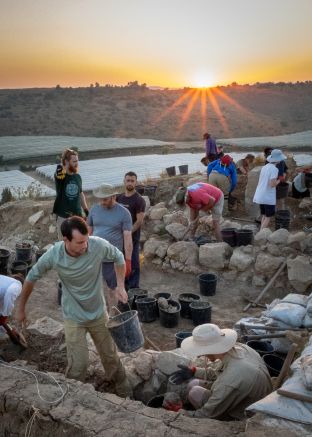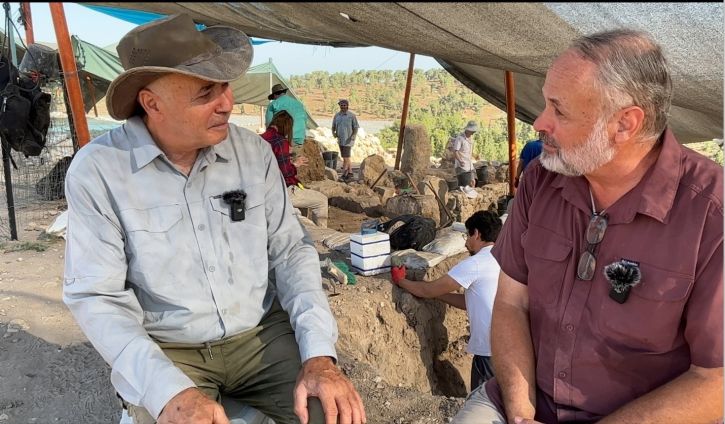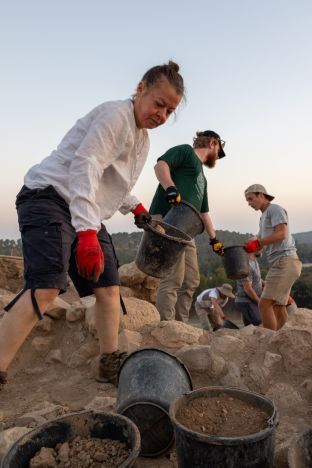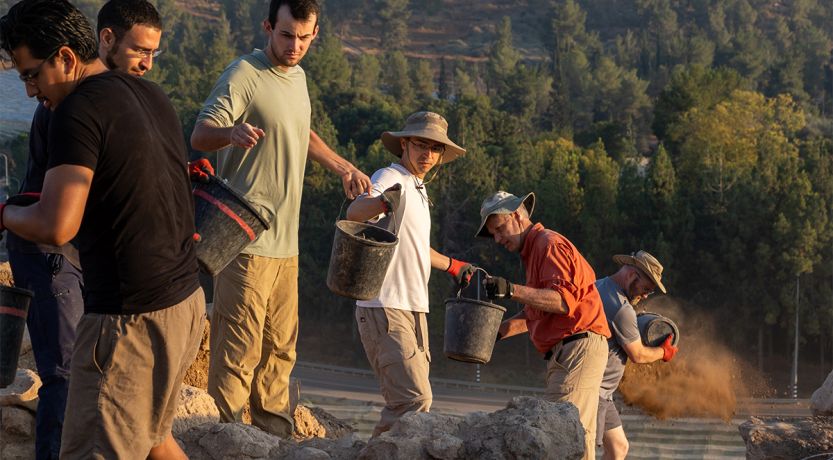As more evidence comes to light, biblical archaeology is increasingly demonstrating that the Bible is historically accurate.
In recent years, archaeological evidence is emerging that more clearly illustrates the time of the early kings of Israel—David, Solomon and Rehoboam—and it is confirming the historical accuracy of the biblical record from the time.
This is important, since it had become common in the field of archaeology to doubt the reliability of the biblical accounts.
Biblical archaeology
The study of biblical archaeology has changed over the years. In the 1800s and early 1900s when archaeologists began in earnest to excavate sites in Palestine, for example, the professionals largely did so with a Bible in one hand and a spade in the other. The Bible was their guide, and many archaeologists had the goal of illuminating and corroborating the biblical record. Finds were interpreted through the lens of Scripture.
In the late 1900s, however, the authority of the Bible as a reliable historical text was being questioned. Many biblical stories and personalities came to be viewed, by increasing numbers, as just myths and legends. The assumption was that the accounts were written down long after the events supposedly described in the Bible’s pages, by people who were essentially manufacturing their history. The reliability of the biblical text was suspect.

According to this view, the stories of David, Solomon and Rehoboam, kings over the powerful biblical kingdom of Judah, were myths. To support this idea, archaeologists would point to the fact that no nonbiblical, independent archaeological evidence had yet been found naming one of these powerful kings or the kingdom they were supposed to have ruled.
Many archaeologists came to believe that during the 10th century B.C.—the time when these kings were supposed to have ruled—the people that eventually show up in the archaeological record more than 200 years later as the kingdom of Judah were just pastoral nomads. There was, the biblical minimalists claimed, no organized kingdom of Judah in the 10th century B.C.
The biblical minimalists became dominant in the field of biblical archaeology and commonly interpreted archaeological finds in ways that contradicted the biblical text.
Argument from silence, silenced
A weakness of the biblical minimalist view has been its reasoning from silence. According to this reasoning, if no archaeological record had been found that named a King David of Judah, then King David must not have existed.
And there was little evidence of fortified cities in southern Israel that would have been built by mighty kings of Judah intent on unifying and strengthening their kingdom, as the Bible indicates David, Solomon and Rehoboam did. City sites dating to that time period were interpreted as Canaanite or Philistine cities, not cities of Judah.
But now that position is being challenged by a series of excavations with finds that clearly date to the 10th century B.C.—the time of David, Solomon and Rehoboam—and distinctly indicate a unified, functioning Judean kingdom, as described in the pages of the Bible.
Khirbet Qeiyafa
Overlooking the Valley of Elah, where the Bible indicates the young David faced off against the Philistine champion Goliath (1 Samuel 17), Hebrew University archaeologist Yosef Garfinkel excavated the remains of a Judahite fortified city. Radiocarbon dating of finds at the site, known as Khirbet Qeiyafa, about 20 miles southwest of Jerusalem, reveal that the city was built and fortified at the time of David.
Dr. Garfinkel associates this site with the biblical city of Shaaraim, mentioned in 1 Samuel 17:52. The Hebrew name of the city means “double gates” or “two gates,” and two monumental four-chambered city gates were found in the excavations of this city wall. No other site from this period in Israel has more than one gate.
Some biblical minimalists claim the city was a Philistine or Canaanite city, but Dr. Garfinkel’s excavations found that the city’s walls were constructed in a style used only in Judah—never by the Philistines or Canaanites. Figurines typically worshipped by the Philistines and Canaanites and found commonly at their sites were completely absent at the city, and of the thousands of animal bones recovered at the site, there was not a single pig bone.
In light of the evidence, Dr. Garfinkel shows, identifying the site as a Philistine or Canaanite city is clearly an error. It was a city of the kingdom of Judah, a major urban building project undertaken at the time of King David, at the edge of the territory of Judah on the border with its adversaries, the Philistines.
In the January/February 2017 issue of Biblical Archaeology Review, Dr. Garfinkel and his associates Saar Ganor and Joseph Baruch Silver wrote:
“At the summit of the site, we found a palatial structure that probably served as the central administrative building for this area of the Davidic kingdom. This, along with the rest of the site, disproves the early assumption by some scholars that David was simply a local chieftain who ruled the area around Jerusalem at most . . .
“Some scholars view King David’s kingdom as a simple agrarian society, sparsely inhabited, with no fortified cities, no administration and no writing. These scholars find it very hard to accept the new discoveries at Qeiyafa, which have completely dismantled these hypotheses” (“Rejected! Qeiyafa’s Unlikely Second Gate,” p. 41).
After digging for seven seasons at Qeiyafa and incorporating evidence from several other sites to add to the understanding of the biblical kingdom of David in the early 10th century, Dr. Garfinkel moved to Tel Lachish to study the latter half of the 10th century—the time of King Rehoboam of Judah.
Tel Lachish
The city of Lachish was the second most important city in the kingdom of Judah, guarding the southern approach to the capital city of Jerusalem. The Bible records that Rehoboam “built cities for defense in Judah . . . And he fortified the strongholds, and put captains in them, and stores of food, oil, and wine” (2 Chronicles 11:5, 11). One of those cities was Lachish (verse 9).
Located on top of a high hill, surrounded by crops of grapes and figs, Lachish commands an impressive view in all directions. It had both an inner and outer wall protecting the city and a palatial structure at the highest point inside the city. The construction of this massive structure dates to the very time of Rehoboam—corroborating the biblical record. It also illustrates the fact that a strong, central government existed in Judah in the 10th century B.C.

Volunteers sponsored by Foundation Outreach International, led by Phil Sandilands, a pastor of the Church of God, a Worldwide Association, joined the excavation team working under the guidance of Dr. Garfinkel in the summer of 2023. The team excavated along a section of the city wall on the northern edge of the site, unearthing pottery, bones and artifacts dating to the time of Rehoboam’s construction and after.
During the excavation, Mr. Sandilands interviewed Dr. Garfinkel about the significance of the site as it reveals the historicity of the biblical record (see “Interview With Archaeologist Yosef Garfinkel”).
Excavations at Lachish also document evidence of the siege of the city by the Assyrian King Sennacherib in 701 B.C., during the time of Judah’s King Hezekiah.
The Assyrian siege of Lachish is one of the most thoroughly attested events in the Bible, archaeologically. There are Assyrian records and wall panels from Sennacherib’s palace in Nineveh describing the same events recorded in Scripture, as well as the evidence found in the ground of Tel Lachish. The remains of the massive Assyrian siege ramp built against the southwest corner of the city are clearly visible today.
Later in history the Bible records the fall of Judah to the Babylonians. Again, the archaeology corroborates the history. In a room by the Lachish city gate, some 20 potsherds were discovered with inscriptions written on them in ink. They are letters dated to the last years before the Babylonian invasion, describing the dire conditions that had come upon them.
As more evidence comes to light, archaeology is increasingly demonstrating the accuracy and historicity of the biblical record.
Interview With Archaeologist Yosef Garfinkel
By Phil Sandilands
Yosef Garfinkel, the Yigal Yadin Professor of Archaeology at the Institute of Archaeology at the Hebrew University of Jerusalem, talks with Phil Sandilands.
Discern: I’m sitting here with Professor Yosef Garfinkel from Hebrew University. He’s leading the excavation at Tel Lachish. I appreciate your taking a few moments.
Yosef Garfinkel: It’s my pleasure.
Can you give us an explanation of why this excavation is so important to biblical archaeology?
Lachish is mentioned 24 times in the biblical tradition. First of all, it’s mentioned in the book of Joshua as one of the mighty Canaanite cities. And, indeed, we have here a mighty Canaanite city that flourished in the Middle Bronze and also in the Late Bronze [Age]. So, this is one tradition.
Then there is a big gap in the biblical tradition, and Lachish is mentioned again only in the time of Rehoboam. Not in the time of David and not in the time of Solomon. And, indeed, when we excavate here, there is a settlement gap for more than 200 years, and the first Iron Age city here—Level V—is, according to radiocarbon dating, from the later part of the 10th century B.C. So again, you can see that the tradition about Rehoboam’s fortification in Lachish fits very nice.
And then Sennacherib’s campaign in 701 B.C. This was a very traumatic event in the biblical historiography. It’s mentioned in three different books: in the book of Kings, in the book of Isaiah and also in Chronicles. And, indeed, here in Lachish, Level III has been destroyed by Sennacherib.
And then we also have traditions from the time of Jeremiah and the end of the first temple [period], that all the fortified cities in Judah have been destroyed besides Azekah and Lachish. And we found here in Lachish letters from this period, and they mention Azekah and Lachish.
So, we can see how the biblical tradition and the archaeology in Lachish fit very well with each other.
Do you think that this excavation has provided anything that perhaps you were unaware of before? What have you found that has given you a different insight?
Our project here is concentrating on Level V, from the 10th century B.C. This is part of a larger project. Another site, at Khirbet Qeiyafa, we excavated and found a fortified city in Judah from the time of King David. Nothing like this was found before. In the city we found a [model of the temple, and after] analyzing the architectural features, [we found] it fit the biblical tradition of Solomon’s palace and temple.
So, we know something about David, something about Solomon, and now who is next? Rehoboam. That’s why we came to Lachish. To see if the biblical tradition about the later part of the 10th century B.C. and the archaeology . . . met together—because there is a whole debate about how much history is embedded in the biblical text relating to the 10th century B.C.
Can you talk a little about minimalist views of archaeology?

The major debate that started nearly 40 years ago was how much historiography has been preserved in the biblical text. The most extreme [minimalist] view, that has been developed in Copenhagen in Denmark, claims that the Bible was written only in the Hellenistic era, so all this description of David, Solomon and Rehoboam is all mythological without any real historical data in it.
I think that the major question is the 10th century B.C., because later in the ninth century B.C. we have [an] Assyrian document about Ahab; we have the Mesha stela in Moab that mentioned Omri and the son of Omri; later we have Sennacherib and Hezekiah. So, people don’t debate so much about the later part of the kingdom of Judah. But the beginning, the 10th century, is really the heart of the debate.
Prior to that, we have the period of the Judges, but David comes along and really does unite the kingdom. Do you think that archaeology is going to prove that?
I’m [only] talking about the kingdom of Judah. Why? Because from one site, Khirbet Qeiyafa, you cannot talk [of] a large empire, or a large kingdom. Maybe in the future a new site or additional sites will be discovered, and we’ll enlarge the picture.
If you ask me, What do we know today? Today we know that the kingdom of David has . . . fortified cities [that have been] found by archaeologists: Khirbet Qeiyafa, Beth Shemesh, Tel en-Nasbeh, Khirbet al-Ra’i. All of them are on the periphery of the kingdom [of Judah], and on a major route leading from the coastal plain, or the mountains, into Jerusalem. So, you can see this might be the core, the urban area of the kingdom of David. And then there were villages over a larger area, of course.
So, what happens next year? Where do you think you’ll be digging next year?
I’m not sure what will happen next year. It’s become clear that we have here about 18 meters of a city wall and houses abutting it relating to the city wall of Rehoboam. So, this is a great achievement. Nothing like this was found before in biblical archaeology.






